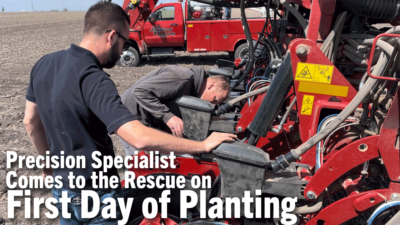While a fair amount of "nervousness" is affecting American agribusiness entering 2009, the four executives interviewed by Farm Equipment generally see a solid year ahead for ag equipment sales. Commodity prices, the cost of farmer inputs, credit and equipment availability are the issues currently receiving the most scrutiny.
Credit Not a Problem
While the cost of money rose dramatically in the last months of 2008, credit availability for equipment purchases is not viewed as a major hurdle as the industry moves into the new year. Dennis Heinecke, AGCO's vice president of sales operations, says, "AGCO Finance is 51% owned by Rabobank and it hasn't been affected at all by the sub-prime crisis. So we have had no issues as far as providing credit to either the professional producer or the rural lifestyle buyer. Other captive financing arms that have exposure to construction businesses can have trouble coming up with cash flow."
Kubota's U.S. vice president of sales and marketing, Greg Embury, agrees. "With a strong and well-financed Kubota Credit Corp., credit hasn't been a concern for either Kubota dealers or its retail customers, and KCC finances a majority of our dealers' sales and inventory.
"I'm sure there will be some affected by the shortage of bank credit, but as far as the end user goes, he's not having trouble getting financing. Our credit company has not changed its credit standards or approval requirements."
"Certainly, reduced commodity prices from a year ago, the weather delays we had this year, and higher input costs are all negatives that are dragging on the farm economy," says Jim Walker. He noted that there's an additional cost to financing now, and that the manufacturer is working on financing programs to help keep things going. The same week of the interview, CNH Capital laid off 15% of its workforce.
Equipment Shortages Easing
If anything, 2008 was a unique year as dealers reported a severe shortage of new equipment, which hampered sales. All of the manufacturers fell short in keeping up with demand," says Walker.
"The equipment shortages that plagued dealers during the last year were the result of a 'boom market,'" according to John Stevenson, New Holland's vice president of sales and marketing for North America. "Everything was great. Commodity prices were great, crops were great and everything just fell into place last year."
With softer international markets and capacity expansions at each of their operations, ag equipment execs don't expect that same scenario developing in 2009.
Strong Preselling Season
Ag equipment makers' confidence moving into the new year is based on a high rate of pre-sells and none are reporting significant order cancellations. "Pre-sell programs on the high-horsepower equipment look very strong for the first 6 months. Farmers traditionally purchase input costs for next year by this time, and many booked a portion of next year's crop at a favorable commodity pricing. With that, most farmers remain willing to make investments for core products for the first half. After that, we expect there to be a 'wait and see' attitude," says Case IH's Walker.
AGCO's Heinecke adds, "We have a strong order bank as a result of a strong early sell program."
Considering the year the farm machinery makers experienced in 2008, Walker says, "It's is a good time for a breather. Pre-sell purchases over the next few months will be looked at very closely — we'll know shortly what the commitments will look like for the third quarter."
Dearth of Used Equipment
Another thing the industry has going for it is a low inventory of used equipment. "One of the factors in the increased dealer sales levels during the past two years has been how much used equipment has been exported," says Heinecke. "The weak dollar provided a huge discount worldwide for used equipment. We need to keep an eye on financial markets to make sure that there are funds for foreign buyers to continue to purchase dealers' used inventory. It's amazing to see what's getting exported — it's cleaned the lots out. The key is when the lots start filling up again. That's something we'll be watching."
This is a concern, too, for Walker. "Over the last couple of years, the availability of good used farm equipment has been at an all-time low. The first signal of a downturn in demand is when dealers start seeing levels of used equipment begin to rise. We haven't seen this yet."
Equipment Pricing Mixed
While the weak dollar has been advantageous to U.S. manufacturers, it's posing problems for manufacturers like Kubota. "It's the biggest thing working against us," say Embury. "It means we've got to pay a lot more for our tractors from Japan and the engines and transmissions for what we build in Georgia. I wouldn't be honest if I didn't tell you we're looking at our pricing strategy for the new year."
At the same time, Heinecke says, "We don't think you're going to see a deflationary effect on pricing. We're monitoring input costs. If steel remains at normal levels, pricing will not need to be as aggressive as it was in 2008."
The Year Ahead
"We don't see any reason for a retreat of the 50% gain we've experienced over the last 2 years," says Walker. "We expect a stable and sound level of industry purchases, with a good demand for equipment manufacturers. Despite volatile commodity prices, Case IH also doesn't see them falling below profitable levels either. "Overall, we see a stable, sound marketplace with predictable net farm incomes."
The Majors Revisited: Dealers are Now Customers
Case IH: A Return to the Basics of Dealer-Manufacturer Relations
AGCO: Planning Key to Navigating a Fast-Changing Landscape
New Holland Re-connecting with 'Front-Line' Customers
Kubota: New Products 'Earn' Dealers' Business
Despite Economic Malaise, Execs See 'Solid Year' for Ag Equipment Sales






Post a comment
Report Abusive Comment